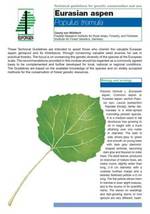Populus tremula - Technical guidelines for genetic conservation and use for Eurasian aspen
This publication has been translated into the following languages:
As a colonising species, aspen has under unmanaged conditions only infrequent and unpredictable availability of spaces to spread into, where the prevailing forest vegetation has been destroyed by disturbances from storm, fire and flood. Under managed conditions the ex situ conservation of aspen populations would depend on deliberately creating open areas for new colonisations or actively planting or seeding this area.
As a general objective, the conservation of genetic resources should maintain the long term adaptive potential of populations, e.g. by in situ conservation of autochthonous stands or long term breeding programmes. Successful in situ conservation of Eurasian aspen would require active management. Removal of late successional tree species and clear cutting of small areas of the aspen stand at intervals of about 20-30 years would provide suitable conditions. Natural seeding from adjacent, dispersed parts of the population would then be successful.
Gene conservation units should be spread throughout the distribution range of the species, preferably including more than one per ecological basic unit. A preliminary assessment of the genetic diversity of the candidate populations is recommended to ensure a high amount of diversity and a low number of clones. Particular attention must be paid to all practices that have an impact on flowering habit and the regeneration process, which determines the effective population size. Conditions for self-seeding and seedling establishment should be improved by completely exposing the mineral soil within or close to aspen stands.
For restored populations, introgression can be limited by creating buffer zones around the population by keeping a distance of several hundred meters from possible hybrid aspen plantations. Active management and evaluation of restored populations including possible clone compositions are necessary. Regeneration by root suckers should be minimised as repetitive vegetative regeneration will reduce genetic diversity.
Authors: Georg von Wühlisch
Journal/Series: EUFORGEN Technical Guidelines for Genetic Conservation and Use
Publication Year: 2009
Publication Format: PDF
ISBN 13: 978-92-9043-802-1
Language: EN
Pages: 6 P.

